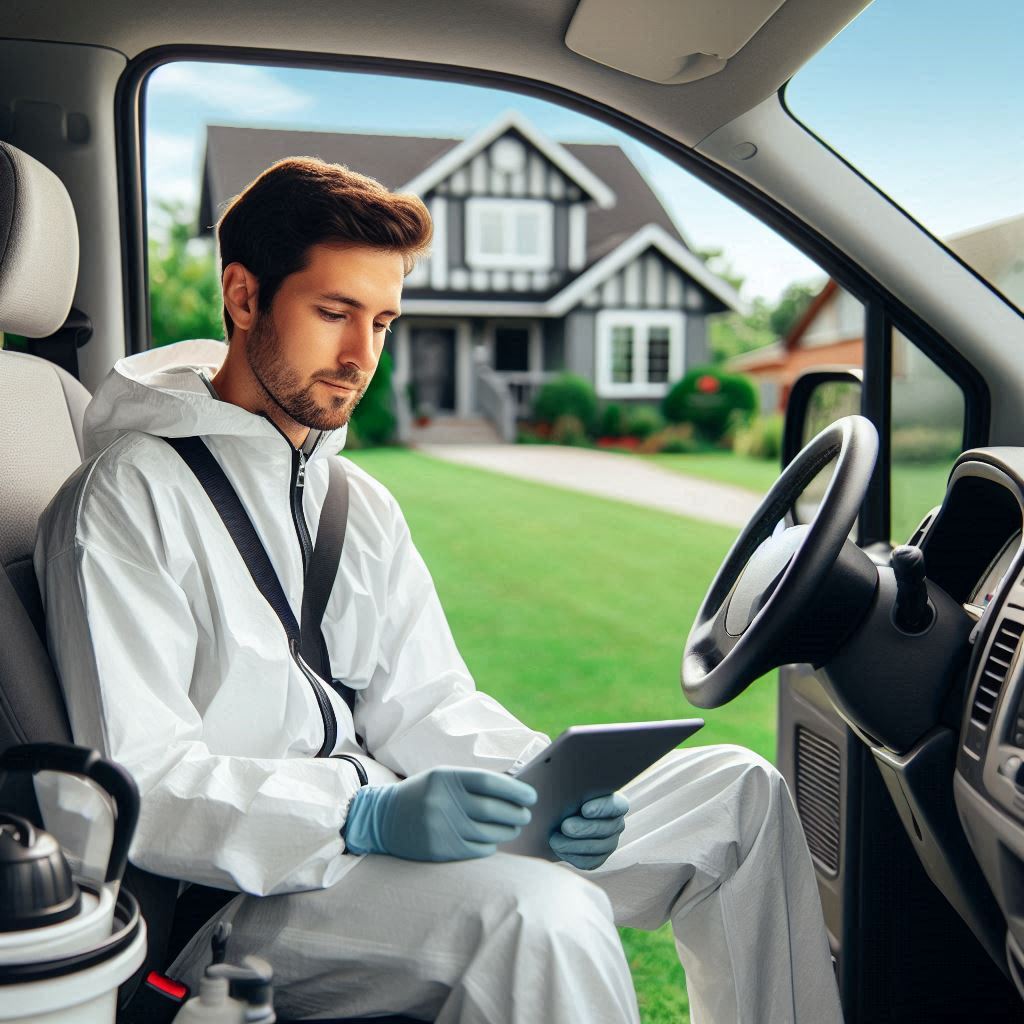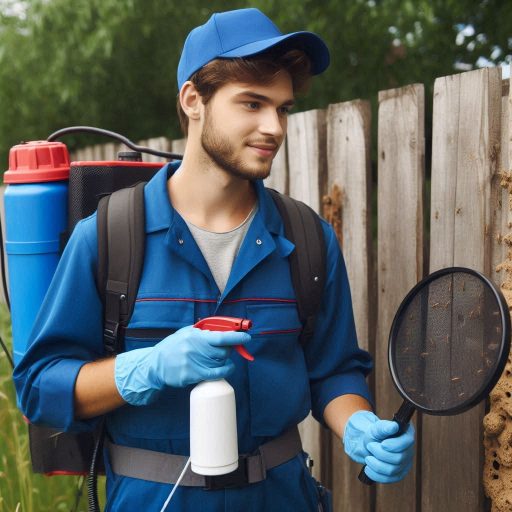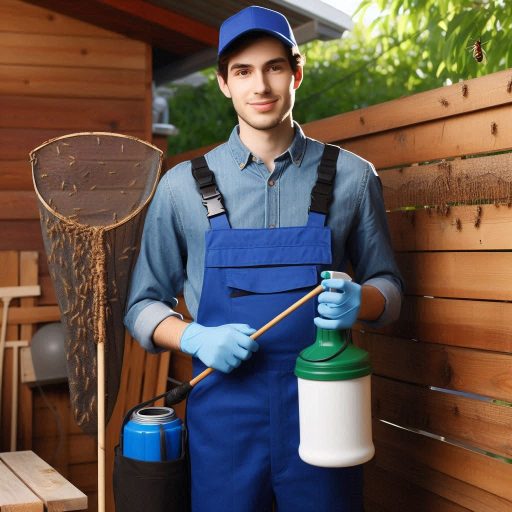Introduction
Let’s explore the environmental impact of pest control services by influencing ecosystems, wildlife, and natural resources.
Pest Control Services and Their Impact on The Environment
Pest control services are essential for maintaining healthy homes and businesses.
However, these services can significantly impact the environment.
Understanding this impact is crucial for making informed choices.
Pest control methods often include:
- Chemical pesticides: These can harm non-target species, contaminate water, and disrupt ecosystems.
- Biological control: Utilizing natural predators can minimize chemical use, but it may also affect local biodiversity.
- Cultural practices: Strategies like crop rotation can reduce pest populations without harmful chemicals.
Importance of Understanding and Minimizing The Environmental Impact of These Services
It‘s important to minimize the environmental effects of pest control services.
This reduction protects beneficial insects, wildlife, and water sources.
Additionally, it promotes sustainable pest management practices.
By understanding the environmental impact, we can make better choices.
Homeowners and businesses can seek eco-friendly pest control options.
This awareness helps create a healthier environment for future generations.
Sustainable practices in pest control will lead to long-lasting benefits for both people and the planet.
Let‘s explore how to implement effective, environmentally friendly pest management solutions.
Types of Pest Control Services
Pest control services aim to manage and eliminate pests that threaten our health and property.
Various methods exist to address these challenges.
Each method impacts the environment differently.
Here, we explore three primary types of pest control: chemical, biological, and mechanical.
Chemical Pest Control
Chemical pest control uses synthetic pesticides to eliminate pests.
This method provides quick results but has notable environmental impacts.
- Contamination: Chemicals can contaminate soil and water sources. This contamination affects plants, animals, and even humans.
- Resistance: Overuse of pesticides can lead to pest resistance. Resistant pests require stronger chemicals, worsening environmental damage.
- Non-target Species: Pesticides often harm beneficial insects, birds, and other wildlife. This disruption can lead to ecological imbalances.
Biological Pest Control
Biological pest control relies on natural predators to manage pest populations.
Transform Your Career Today
Unlock a personalized career strategy that drives real results. Get tailored advice and a roadmap designed just for you.
Start NowThis method is generally more environmentally friendly.
- Natural Balance: Introducing natural predators helps maintain ecological balance. It promotes biodiversity and reduces reliance on chemicals.
- Sustainability: Biological methods can be sustainable over the long term. They typically require less intervention once established.
- Potential Risks: However, introducing non-native species can cause unintended consequences. They may become invasive and disrupt local ecosystems.
Mechanical Pest Control
Mechanical pest control involves physical methods to remove or deter pests.
This approach is often less harmful to the environment.
- Traps: Using traps can effectively control pest populations without chemicals. They target specific pests, minimizing harm to other species.
- Barriers: Installing barriers, like screens and caulking, prevents pests from entering homes.
This method helps maintain a pest-free environment without ecological damage. - Labor-Intensive: Mechanical methods can require more labor and time. However, they are a safer choice for both humans and the environment.
In fact, understanding the types of pest control services available is crucial.
Each method‘chemical, biological, and mechanical‘affects the environment differently.
Chemical methods can lead to contamination and resistance, while biological methods support natural ecosystems.
Mechanical methods provide a more sustainable approach but require more effort.
Choosing the right pest control method can protect both our health and the environment.
Read: How Much Do Pet Groomers Earn in the USA?
Use of Chemical Pesticides
Widespread Use of Chemical Pesticides in Pest Control Services
Pest control services often rely on chemical pesticides to manage pests effectively.
These pesticides are designed to eliminate unwanted insects and rodents quickly.
The widespread use of chemical pesticides occurs in agriculture, residential areas, and commercial properties.
Farmers apply them to protect crops, while homeowners use them to safeguard their homes.
Pest control companies utilize these chemicals to ensure rapid and effective pest removal.
Unfortunately, their benefits come with significant environmental costs.
Negative Impact of Chemical Pesticides on the Environment
Chemical pesticides can contaminate soil and water sources, leading to long-lasting environmental damage.
When applied, these substances can seep into the ground, affecting soil quality.
Over time, they disrupt the natural ecosystem and reduce biodiversity.
Many chemical pesticides are not biodegradable, meaning they remain in the environment for extended periods.
This persistence can harm beneficial insects, birds, and other wildlife essential for maintaining ecological balance.
The runoff from treated areas can carry pesticides into nearby water bodies.
Streams, rivers, and lakes can become polluted, impacting aquatic life.
Fish and other organisms may suffer from pesticide exposure, leading to population declines.
Additionally, contaminated water can pose serious risks to human health.
Communities relying on these water sources may face increased health issues.
Transform Your Career Today
Unlock a personalized career strategy that drives real results. Get tailored advice and a roadmap designed just for you.
Start NowChemical pesticides also affect soil organisms, disrupting nutrient cycles.
Healthy soil relies on a diverse range of microorganisms that help decompose organic matter.
Pesticides can kill these organisms, leading to poorer soil quality and reduced agricultural productivity.
Consequently, farmers may need to apply more fertilizers to achieve similar yields, further exacerbating the issue.
Chemical pesticides can also pose risks to non-target species, including pollinators.
Bees and butterflies are vital for pollinating crops and maintaining biodiversity.
Read: How Much Do Pet Groomers Earn in the USA?
Harmful Effects on Non-Target Species
Pest control services can unintentionally harm non-target species, including beneficial insects, birds, and mammals.
These unintended consequences can disrupt ecosystems, reducing biodiversity and damaging environmental health.
Below are key ways these services impact non-target species and why it’s essential to manage these risks.
Negative Impact on Beneficial Insects
- Insecticides often kill pollinators like bees, butterflies, and ladybugs.
- Predatory insects that naturally control pests can also be affected, increasing pest populations.
- Loss of pollinators reduces plant reproduction, threatening food crops and native vegetation.
Harm to Birds and Small Mammals
- Birds consuming pesticide-contaminated insects risk poisoning and behavioral changes.
- Rodenticides used to control rats can poison non-target animals such as owls and foxes.
- Secondary poisoning occurs when predators eat contaminated prey, disrupting natural food chains.
Indirect Effects on the Ecosystem
- Eliminating insects impacts the diet of birds, amphibians, and mammals.
- Reduction of prey species forces animals to seek food in urban areas, increasing human-wildlife conflict.
- When predatory species decline, pest populations can grow unchecked, requiring more chemical treatments.
The Need for Eco-Friendly Pest Control
- Choosing targeted or biological control methods reduces harm to beneficial species.
- Integrated Pest Management (IPM) emphasizes using chemicals only when necessary.
- Raising awareness of non-toxic alternatives supports ecosystem health and biodiversity preservation.
By carefully evaluating pest control practices, we can minimize their harmful impact on non-target species.
Sustainable approaches help maintain ecological balance while effectively managing pest populations.
Read: Top Pet Grooming Conferences and Expos in the USA

Development of Pest Resistance
How Repeated Use of Certain Pesticides Can Lead to the Development of Pest Resistance
Pest resistance is a significant concern in pest control services.
It occurs when pests adapt to survive exposure to specific pesticides.
This adaptation often results from repeated pesticide use.
Over time, the surviving pests pass on their resistant traits to their offspring.
As a result, pest populations become increasingly resistant.
This phenomenon leads to a cycle of escalating pesticide application.
Implications of Pest Resistance on the Effectiveness of Pest Control Services and the Environment
The development of pest resistance can severely impact the effectiveness of pest control services.
Initially effective pesticides may lose their potency against targeted pests.
As resistance builds, pest control providers must use higher pesticide doses.
This approach may yield diminishing returns, necessitating the use of even stronger chemicals.
Consequently, pest control becomes less efficient and more costly.
Service providers face significant challenges in managing resistant pest populations.
Transform Your Career Today
Unlock a personalized career strategy that drives real results. Get tailored advice and a roadmap designed just for you.
Start NowThe implications of pest resistance extend beyond pest control services.
Increased pesticide application harms the environment.
Higher chemical concentrations can lead to soil and water contamination.
These contaminants can affect non-target organisms, including beneficial insects, plants, and aquatic life.
The ecosystem suffers as biodiversity decreases.
Moreover, pesticide residues can accumulate in the food chain, posing risks to human health.
To combat pest resistance, integrated pest management (IPM) strategies are crucial.
IPM focuses on combining multiple control methods rather than relying solely on pesticides.
This approach reduces the selection pressure on pests, minimizing the development of resistance.
For example, cultural practices, such as crop rotation and habitat manipulation, can help control pest populations.
Read: Educational Requirements for Childcare Workers Explained
Alternative Eco-Friendly Pest Control Methods
Eco-friendly pest control methods are essential for minimizing the environmental impact of pest management services.
These methods prioritize sustainable practices while effectively managing pest populations.
Here, we discuss five alternative eco-friendly pest control methods, including Integrated Pest Management (IPM) and biological control.
Eco-friendly pest control methods such as integrated pest management (IPM) and biological control.
Integrated Pest Management (IPM)
IPM combines various strategies to manage pests sustainably.
It emphasizes prevention, monitoring, and control.
IPM begins with identifying pests accurately and understanding their life cycles.
This knowledge helps develop targeted strategies.
By using a combination of biological, cultural, and physical methods, IPM reduces reliance on chemical pesticides.
This approach not only manages pests but also protects beneficial organisms.
Biological Control
Biological control uses natural predators or parasites to control pest populations.
For example, ladybugs effectively reduce aphid numbers.
Introducing these beneficial insects creates a balanced ecosystem.
This method reduces the need for synthetic pesticides, which can harm non-target species.
By fostering natural enemies, biological control minimizes environmental disruption and promotes biodiversity.
How these methods can reduce the environmental impact of pest control services while effectively managing pests
Cultural Control
Cultural control involves changing farming practices to deter pests.
Techniques include crop rotation, intercropping, and adjusting planting dates.
These practices disrupt pest life cycles and reduce their populations.
For instance, rotating crops can prevent pest establishment in a specific area.
Cultural control not only lowers pest numbers but also enhances soil health and resilience.
Mechanical Control
Mechanical control employs physical methods to manage pests.
Traps, barriers, and manual removal are common techniques.
For instance, using sticky traps captures flying insects, while row covers protect plants from pests.
These methods provide immediate results without harmful chemicals.
By implementing mechanical control, pest services can effectively reduce populations while safeguarding the environment.
Organic Pesticides
Organic pesticides, derived from natural sources, offer a safer alternative to synthetic chemicals.
Products containing neem oil, diatomaceous earth, or insecticidal soap effectively control pests.
These substances break down more quickly in the environment, minimizing long-term impacts.
Organic pesticides target specific pests while preserving beneficial insects and pollinators.
This targeted approach reduces chemical exposure and promotes environmental health.
Implementing these eco-friendly pest control methods can significantly reduce the environmental impact of pest control services.
By adopting IPM, biological control, cultural practices, mechanical methods, and organic pesticides, pest management professionals can achieve effective pest control.
These approaches protect human health and safeguard ecosystems from the adverse effects of traditional pesticides.
In general, adopting alternative eco-friendly pest control methods is vital for sustainable pest management.
By integrating these practices, we can effectively manage pests while protecting our environment.
It is essential for pest control services to prioritize eco-friendly strategies, ensuring a healthier planet for future generations.
Importance of Proper Application
Pest control services play a vital role in maintaining healthy environments.
However, improper application of these services can lead to significant environmental harm.
To minimize negative impacts, professionals must adhere to best practices in pest management.
Significance of Proper Application
Proper application begins with a thorough assessment of the pest issue.
Trained professionals evaluate the type of pest, the severity of the infestation, and the affected areas.
This assessment informs the choice of appropriate pest control methods.
By selecting the right approach, professionals can reduce the risk of harm to non-target species and the surrounding ecosystem.
One key factor in effective pest control is understanding the lifecycle of pests.
Knowledgeable technicians know when to apply treatments for maximum efficacy.
For instance, applying pesticides during a pest’s reproductive cycle can significantly reduce population growth.
This strategic timing minimizes the need for repeated applications, reducing chemical exposure to the environment.
Moreover, the choice of products used in pest control services greatly influences environmental impact.
Professionals should opt for environmentally friendly solutions whenever possible.
These products often contain natural ingredients that are less harmful to ecosystems.
By using safer alternatives, pest control technicians protect beneficial insects and other wildlife.
The Role of Trained Professionals
Trained professionals also play a crucial role in ensuring safe application practices.
They are equipped with the necessary knowledge to apply treatments correctly.
Proper training includes understanding equipment calibration and safety protocols.
This knowledge prevents over-application, which can lead to chemical runoff and contamination of soil and water.
Additionally, professionals educate clients on the importance of integrated pest management (IPM) practices.
IPM emphasizes prevention, monitoring, and control strategies that reduce reliance on chemical treatments.
By incorporating IPM, pest control services can effectively manage pests while minimizing environmental impact.
Clients who understand these principles are more likely to support eco-friendly pest management solutions.
Communication between pest control professionals and clients is essential.
Professionals should provide clear instructions on how to prepare the area before treatment.
Clients must understand any necessary precautions to take afterward.
This communication fosters a collaborative approach to pest management, enhancing its overall effectiveness.
Finally, regular follow-up assessments are crucial after pest control services are applied.
Trained professionals should monitor the treated areas to evaluate the effectiveness of their methods.
They can identify any remaining pests and adjust strategies as needed.
This ongoing evaluation not only ensures successful pest management but also protects the environment from potential harm.
Proper application of pest control services is crucial for minimizing environmental harm.
Trained professionals play a significant role in this process.
By assessing situations accurately, choosing appropriate products, and employing safe practices, they can effectively manage pests while safeguarding ecosystems.
Investing in proper pest control is an investment in a healthier environment for all.
Transform Your Career Today
Unlock a personalized career strategy that drives real results. Get tailored advice and a roadmap designed just for you.
Start NowExplore Further: Maximizing Fuel Efficiency for Taxi/Rideshare Drivers
Explore Further: Event Planning on a Budget: Tips and Tricks
Regulations and Guidelines: Ensuring Responsible Pest Control Practices
Pest control services must adhere to various regulations designed to protect the environment and public health.
These rules ensure that pest management practices minimize harm to non-target organisms, ecosystems, and human health.
Below are some key regulations governing pest control operations:
Major Pest Control Regulations and Guidelines
- Federal Insecticide, Fungicide, and Rodenticide Act (FIFRA) ‘ Regulates the sale and use of pesticides to prevent environmental damage.
- Endangered Species Act (ESA) ‘ Protects threatened wildlife from pesticides harmful to their habitats.
- Clean Water Act (CWA) ‘ Controls pesticide runoff into water bodies to prevent contamination.
- State Pesticide Regulations ‘ Each state may enforce additional pesticide rules based on local environmental needs.
- Occupational Safety and Health Administration (OSHA) ‘ Ensures safe pesticide use in workplaces to prevent harmful exposure.
Importance of Strict Adherence to Regulations
Following these guidelines ensures sustainable pest control practices without compromising environmental health.
Non-compliance can result in severe consequences, including:
- Pollution of soil and water ‘ Improper pesticide disposal contaminates natural resources.
- Biodiversity loss ‘ Overuse of pesticides harms beneficial insects and wildlife.
- Human health risks ‘ Pesticide misuse can expose people to hazardous chemicals.
Key Practices for Compliance
- Use of Eco-Friendly Pesticides ‘ Choose products with minimal environmental impact.
- Integrated Pest Management (IPM) ‘ Combine biological, cultural, and chemical methods for effective and sustainable control.
- Proper Disposal of Pesticides ‘ Follow disposal guidelines to prevent environmental pollution.
- Monitoring and Documentation ‘ Keep detailed records to ensure compliance and demonstrate responsible practices.
Strict adherence to pest control regulations promotes safe environments and sustainable ecosystems.
Businesses must continuously train employees and update procedures to meet evolving guidelines.
Responsible pest management is essential not only for environmental safety but also to maintain public trust.
Conclusion
Pest control services play a crucial role in managing infestations but can also impact the environment.
Chemicals used in pest control often affect non-target organisms, contaminate water sources, and disrupt ecosystems.
Understanding these environmental risks is essential for making informed decisions.
Key Points Recap
- Chemical Pesticides: Harm beneficial insects and pollute soil and water.
- Ecosystem Disruption: Reduces biodiversity by harming pollinators and natural predators.
- Air and Water Pollution: Runoff and drift spread harmful chemicals beyond treated areas.
- Chemical Resistance: Overuse leads to pest immunity, requiring more toxic solutions.
We must acknowledge these risks and consider eco-friendly solutions.
Safer pest control alternatives like biological controls, organic pesticides, and integrated pest management (IPM) strategies minimize environmental harm.
Take Action
- Opt for non-toxic methods like traps or repellents whenever possible.
- Support pest control companies that prioritize sustainable and eco-friendly practices.
- Use pesticides sparingly and only as a last resort.
Choosing environmentally conscious methods can protect ecosystems and ensure long-term pest control success.
Let‘s work together to reduce environmental harm while managing pests responsibly.
[E-Books for Sale]
The Big Book of 500 High-Paying Jobs in America: Unlock Your Earning Potential
$19.99 • 500 High-Paying Jobs • 330 pages
Explore 500 high-paying jobs in America and learn how to boost your career, earn more, and achieve success!
See All 500 High-Paying Jobs of this E-Book
1001 Professions Without a Degree: High-Paying American Jobs You Can Start Now
$19.99 • 1001 Professions Without a Degree • 174 pages
Discover 1001 high-paying jobs without a degree! Unlock career tips, skills, and success strategies for just $19.99!




